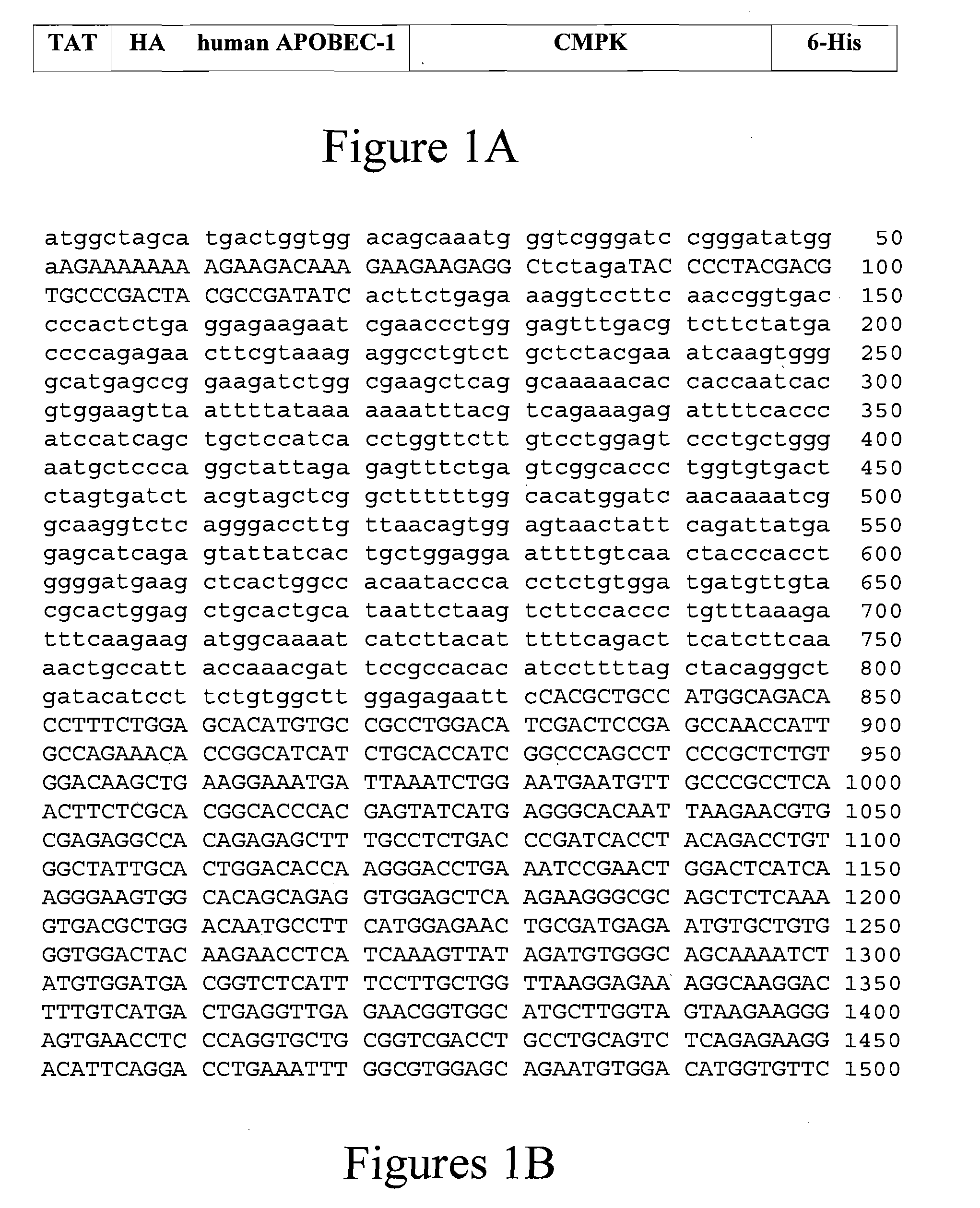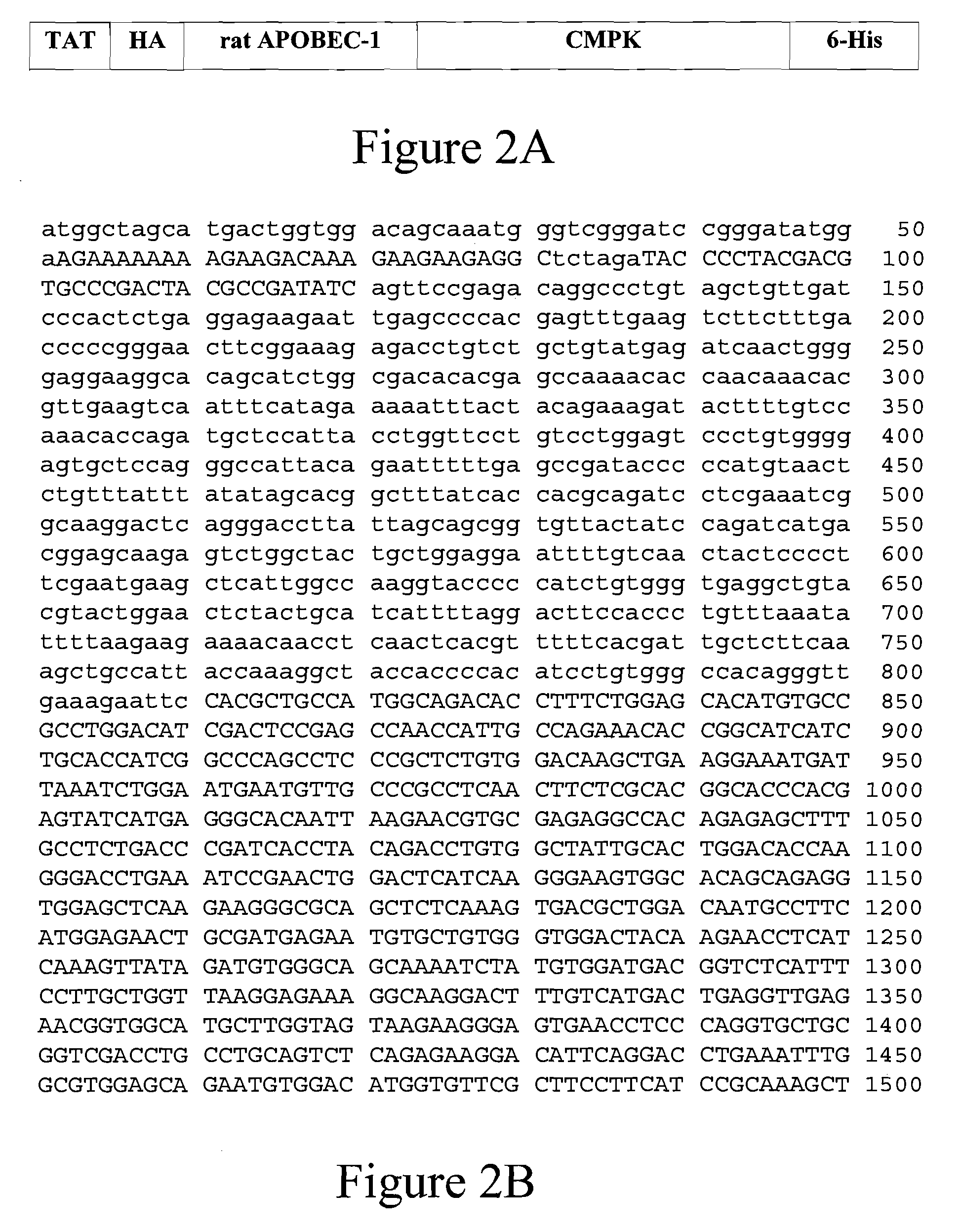Methods and Compositions for Modifying Apolipoprotein B mRNA Editing
a technology of apolipoprotein and mrna, which is applied in the field of chimeric proteins, can solve the problems of affecting the effect of gene therapy, affecting the growth of fungi, and usually not having vldl, so as to improve the intracellular apobec-1, and improve the effect of apobec-1
- Summary
- Abstract
- Description
- Claims
- Application Information
AI Technical Summary
Benefits of technology
Problems solved by technology
Method used
Image
Examples
example 1
Generation of TAT Fusion Protein
[0106]The induction of hepatic apolipoprotein B mRNA editing was sought through TAT mediated APOBEC-1 protein transduction into liver cells. It has been shown that linking an 11-amino-acid protein transduction domain (PTD) of HIV-1 TAT protein to heterologous protein conferred the ability to transduce into cells (Nagahara et al., “Transduction of full-length TAT fusion proteins into mammalian cells: TAT-p27Kip1 induces cell migration,”Nature Med. 4:1449-1452 (1998); Schwarze et al., “In vivo protein transduction: delivery of a biologically active protein into the mouse,”Science 285:1569-1572 (1999); Vocero-Akbani et al., “Killing HIV-infected cells by transduction with an HIV protease-activated caspase-3 protein,”Nature Med. 5:29-33 (1999), each of which is hereby incorporated by reference in its entirety). PTD-linked protein transduced into ˜100% of cells and the transduction process occurred in a rapid and concentration-dependent but receptor- and t...
example 2
In Vitro Introduction of TAT-rAPOBEC-CMPK into McArdle Cells
[0109]The uptake of TAT-rAPOBEC-CMPK, SEQ ID No: 4, into McArdle cells was evaluated using an antibody reactive with the HA epitope and fluorescence microscopy.
[0110]McArdle RH7777 cells were obtained from ATCC (Manassas, Va.) and cultured as described previously (Yang et al., “Partial characterization of the auxiliary factors involved in apo B mRNA editing through APOBEC-1 affinity chromatography,”J. Biol. Chem. 272:27700-27706 (1997), which is hereby incorporated by reference in its entirety). McArdle cells, grown on six well cluster plates were treated with either TAT-rAPOBEC-CMPK or TAT-CMPK for the indicated times. Cells were then washed extensively with PBS and subsequently fixed with 2% paraformaldehyde, permeabilized with 0.4% Triton X100, blocked with 1% BSA and reacted with affinity purified anti-HA (Babco, Berkeley, Calif.) and affinity purified FITC conjugated goat anti-mouse secondary antibody (Organon Teknika,...
example 3
Measurement of Apolipoprotein B mRNA Editing in TAT-rAPOBEC-CMPK Transduced McArdle Cells
[0113]Given that TAT-CMPK entered McArdle cells, as demonstrated in Example 2, an evaluation was made as to whether this would affect apolipoprotein B mRNA editing activity (FIG. 8). Cells were treated with the indicated amounts of TAT-CMPK (using the same preparation of protein as in FIG. 7) and total cellular RNA was isolated following 24 h and the proportion of edited apolipoprotein B mRNA measured.
[0114]Total cellular RNA was isolated from cells with Tri-Reagent (Molecular Research Center, Cincinnati, Ohio) according to manufacture's recommendations. Purified RNAs were digested with RQ-DNase I (Promega, Madison, Wis.) and with RsaI (Promega) restriction enzyme that has a recognition site between the PCR annealing sites of target substrates to ensure the removal of the contaminating genomic DNA.
[0115]Editing activity was determined by the reverse transcriptase-polymerase chain reaction (RT-PC...
PUM
 Login to View More
Login to View More Abstract
Description
Claims
Application Information
 Login to View More
Login to View More - R&D
- Intellectual Property
- Life Sciences
- Materials
- Tech Scout
- Unparalleled Data Quality
- Higher Quality Content
- 60% Fewer Hallucinations
Browse by: Latest US Patents, China's latest patents, Technical Efficacy Thesaurus, Application Domain, Technology Topic, Popular Technical Reports.
© 2025 PatSnap. All rights reserved.Legal|Privacy policy|Modern Slavery Act Transparency Statement|Sitemap|About US| Contact US: help@patsnap.com



